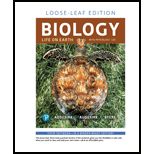
Concept explainers
If you have ever accidentally walked into a spider web, then you know that the strands of the web can be very sticky indeed. And the small insects one sees trapped in spider webs seem to be quite firmly snared. So how does the spider that built the web scuttle so easily across it without getting stuck? One key factor is that the web is not entirely sticky. The web’s scaffolding is made from non-sticky strands, with sticky ones restricted to the capture area. So a moving spider can often simply stay on the non-sticky strands and avoid the sticky ones. But the spider’s distinctive claws also help. These claws, in conjunction with specialized hairs on the tips of its legs, allow a spider leg to grip a single web strand and then release it. A spider moving in this fashion, grasping strands with only the very tips of its legs, will have only a tiny surface area in contact with the web at anyone time. Thus, even if the spider grips a sticky strand with one of its legs, it can easily pull loose, just as you can if you step on a wad of chewing gum. In contrast, an unsuspecting fly that crashes into the web will contact a number of strands with many parts of its body simultaneously and be stuck fast.
Why Spiders Don’t Stick to Their Own Webs?
Want to see the full answer?
Check out a sample textbook solution
Chapter 24 Solutions
Pearson eText Biology: Life on Earth with Physiology -- Instant Access (Pearson+)
- What is marine collagen? -What type of collagen does it contain? what is it obtained from?... etc. Please explain in detail. Please do not copy paste, write in your own words.arrow_forwardA jar has 2 amoebas in it. Amoeba splits into two and double its size once every second. The jar will be completely filled in 20 seconds. How long would it take to fill the jar if it had 8 amoebas in it? arrow_forwardWhy are sperm the only body cells that need to have a flagellum?arrow_forward
- 5. What would happen if tropomyosin couldn't change confirmation in the presence of Ca2+ binding to troponin? A)ACh wouldn't be released from vesicles B)Myosin couldn't bind to troponin C)Myosin couldn't bind to ATP D)Myosin couldn't bind to actin E)Ca2+ wouldn't be released from the SRarrow_forwardOrganisms of which of the following kingdom do nothave nuclear membrane ?(a) Protista (b) Fungi(c) Monera (d) Plantae Please try to break the solutions into as many steps as practically possible and the steps should come one by one and they should be short and crisp and plagiarism-free.arrow_forwardYou are studying how a newly discovered virus in bats enters their cells. When you examine cells that have taken up the virus, you find virus particles inside clathrin-coated vesicles. What membrane transport mechanismis the virus using to get inside the bat cells? Diatoms are protists that have complex glassy structures in their cell walls. These structures form within the Golgi apparatus. How do these structures reach the cell wall without having to pass through the plasma membrane? What is the evolutionary advantage of bacteria that have flagella vs. bacteria that do not?arrow_forward
- You are studying a plant and inject fluorescein, a fluorescent dye, into a single cell on the surface of the plant. After a brief period of time, the dye spreads to cells neighboring the injected cell. What do you conclude? only one options: The cells are connected by the cell wall. The cells are connected by tight junctions. The cells are connected by gap junctions. The cells are connected by plasmodesmata.arrow_forwardIn preparation for a summer barbecue, your classmate cuts up chickens on a wooden carving board. After running the board under water for a few seconds, he uses it to cut up tomatoes, lettuce, peppers, and other salad ingredients. What sort of trouble may occur?arrow_forwardDiatoms are protists that have complex glassy structures in their cell walls. These structures form within the Golgi apparatus. How do these structures reach the cell wall without having to pass through the plasma membrane? What is the evolutionary advantage of bacteria that have flagella vs. bacteria that do not?arrow_forward
- Select the term that does not belong in the group. For example, in the group Atom Cell Tissue Alive Organ you would select "alive", because all of the other terms are levels of organization. "Alive" is not a level of organization, so it does not belong. Malleus Incus Cartilage Stapes ["", "", "", ""] Tectorial membrane Ampulla Semicircular canals Cupula ["", "", "", ""] Gravity Linear acceleration Sound waves Rotation ["", "", "", ""] Vestibular nerve Optic nerve Cochlear nerve Vestibulocochlear nerve ["", "", "", ""]arrow_forwardWhat feature do plasmodesmata have? What function do they have in plants?arrow_forwardWhich of the following distinguishes axial filaments from flagella? Flagella are short and axial filaments are long. Axial Filaments are composed of actin and flagella are composed of flagellin. Axial filaments are found in cocci. Flagella are found in gram-negative bacteria. Axial filaments do not extend from the cell.arrow_forward
 Biology (MindTap Course List)BiologyISBN:9781337392938Author:Eldra Solomon, Charles Martin, Diana W. Martin, Linda R. BergPublisher:Cengage Learning
Biology (MindTap Course List)BiologyISBN:9781337392938Author:Eldra Solomon, Charles Martin, Diana W. Martin, Linda R. BergPublisher:Cengage Learning Human Physiology: From Cells to Systems (MindTap ...BiologyISBN:9781285866932Author:Lauralee SherwoodPublisher:Cengage Learning
Human Physiology: From Cells to Systems (MindTap ...BiologyISBN:9781285866932Author:Lauralee SherwoodPublisher:Cengage Learning Biology Today and Tomorrow without Physiology (Mi...BiologyISBN:9781305117396Author:Cecie Starr, Christine Evers, Lisa StarrPublisher:Cengage Learning
Biology Today and Tomorrow without Physiology (Mi...BiologyISBN:9781305117396Author:Cecie Starr, Christine Evers, Lisa StarrPublisher:Cengage Learning


